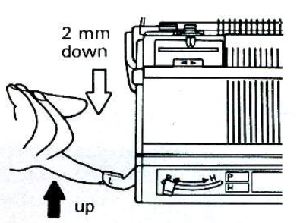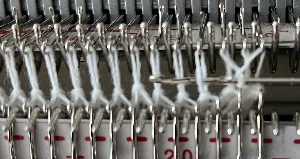A note: Gimp has been updated twice in 2025 with lots of new menus, bells and whistles, and methods described in many of my posts now do not perform as expected. So far I have resisted reverting to the previous version. In 2024 it took months for the bugs to be sorted out and resolved.
Most of my separations at the moment are being performed using ArahPaint
on a Mac with the latest OS, Sequoia15.5.
In 2015 I published a post on working with generated mazes: Gimp charting 1The long lines of black or white cells make them unsuitable for traditional fair isle knitting.
There are many ways to achieve the same goals. One option for converting small-scale repeats is to begin with a file previously used and separated, magnified to 1800X.
1. using the rectangle select tool, begin on row 1, extending the handle outside the image, I work from left to right
2. hold down the shift key and continue selecting every other row. As each row is selected, it is outlined with dots. The handles to the right and left of that row serve as guides as to the last row worked, moving up as separation progresses. Clicking on the rectangle select tool at any point fixes the layer, and the dotted lines will disappear. 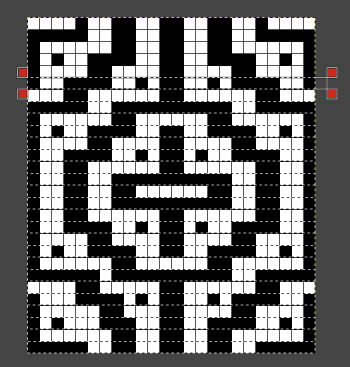 The process could be performed in steps, with guides placed before color inverting the previous steps in the sequence and moving on to the next.
The process could be performed in steps, with guides placed before color inverting the previous steps in the sequence and moving on to the next. 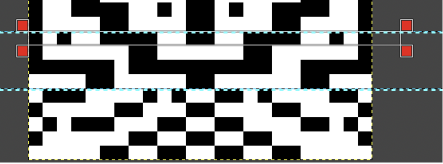 The guides remain until they are removed by clicking on the check mark beside show guides,
The guides remain until they are removed by clicking on the check mark beside show guides, ![]() or with the / / command.
or with the / / command.
This method may be more error-prone than using layers or colors to make rows transparent when developing large designs.
3. after each pertinent row has been selected, choose the color invert option and save the resulting file. The first steps in the separation are completed.
The final file must be color-inverted and lengthened X2 before knitting. The result matches the separation in the previous post.  Holding down the shift key when using the pencil tool on any image produces very different results.
Holding down the shift key when using the pencil tool on any image produces very different results. 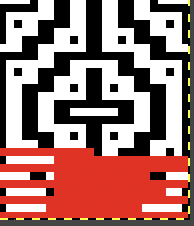 My samples continue to be knit on the 930 using img2track, a download program I find reliable and easy to use. The only errors in programming I have encountered were due to operator errors, not software ones.
My samples continue to be knit on the 930 using img2track, a download program I find reliable and easy to use. The only errors in programming I have encountered were due to operator errors, not software ones.
Since 2015 working with larger images has become far less daunting as my methods for color separations of mazes and mosaics have evolved.
Laura Kroegler’s online Mosaic Pattern Generator is still available. Returning to it, and using these parameters  the pngs were downloaded both in red and then again in black and white.
the pngs were downloaded both in red and then again in black and white. 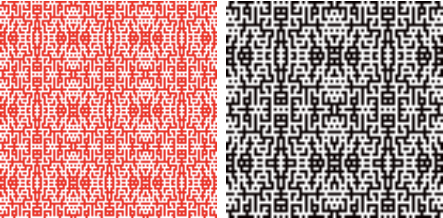 A 38X38 stitch repeat was isolated, and using Layer/Transparency/Color to Alpha a knittable mosaic design was obtained which, when knit, would require elongation X2 for color changing every 2 rows
A 38X38 stitch repeat was isolated, and using Layer/Transparency/Color to Alpha a knittable mosaic design was obtained which, when knit, would require elongation X2 for color changing every 2 rows ![]()
 The last file, doubled in length to 76 rows in height, requires no further processing
The last file, doubled in length to 76 rows in height, requires no further processing ![]() The separations are achieved now in just minutes.
The separations are achieved now in just minutes.
The proof of concept swatch: when using repeats that are so much wider, one must commit to far larger swatches to test them. In addition, the placement in the final piece may matter with shifting the pattern to highlight a preferred center, here the machine was allowed to place the design as a simple overall one on 78 stitches by 116 rows.  There are droves of inspiring large-scale mosaic crochet images published nowadays, which led me to wonder about DIY similar large graphic mosaics in machine knitting.
There are droves of inspiring large-scale mosaic crochet images published nowadays, which led me to wonder about DIY similar large graphic mosaics in machine knitting.
They can be built from scratch, or published designs may be used and converted for use in machine knitting.
A follow-up post on DIY Figurative designs in mosaic knitting
As a start, I performed the first color separation with shortcuts, mirroring the cleaned-up repeat, did not verify each step with tiling, and committed to knitting a test swatch.
A 68X136 repeat X2 in width and at least 40 more rows in height produced a 16X24-inch test swatch, on which a couple of missing pixels became noticeable.
The swatch was also knit using slip in both directions on the main bed, which produces a narrow, short fabric in contrast to wide and short when using the tuck setting,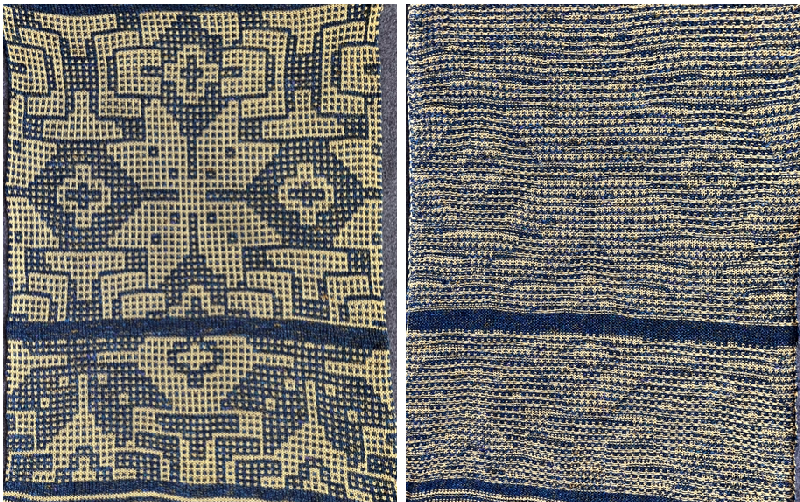 back to the drawing board.
back to the drawing board.
DIY: The initial approach is similar to that used in creating mock filet crochet shapes on the machine.
With present tools ie Gimp begin with choosing any symmetrical design where the shaping of the motif occurs in single rows, this one measures 23X23 ![]()
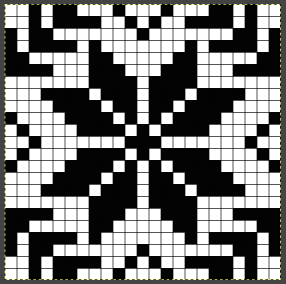 scale the file X3 in both directions to 69X69
scale the file X3 in both directions to 69X69 
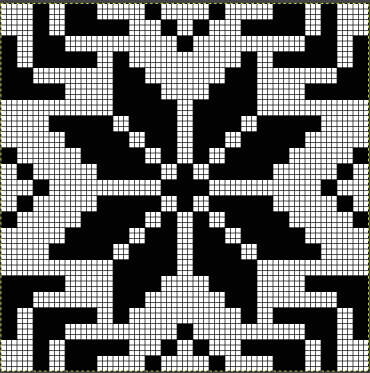 save this brush to use later for bucket-fill the design.
save this brush to use later for bucket-fill the design.  Choose fuzzy select by color/black, each shape will be surrounded by a dotted line
Choose fuzzy select by color/black, each shape will be surrounded by a dotted line 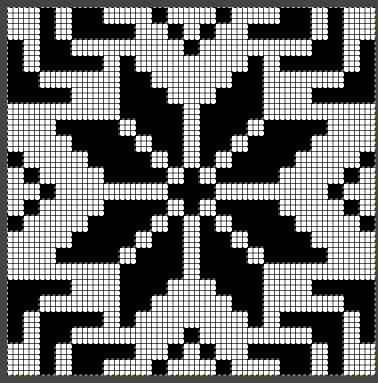 bucket fill the selections with the saved pattern
bucket fill the selections with the saved pattern  click on rectangle select to fix the layer, work on and clean up the repeat, and check a magnified version for any missing or misplaced pixels.
click on rectangle select to fix the layer, work on and clean up the repeat, and check a magnified version for any missing or misplaced pixels.  Save the png. for reference before continuing to work.
Save the png. for reference before continuing to work.  Make one of 2 choices. If the goal is to place a motif and to add borders or horizontal additional design stripes, create a new canvas, larger than the above, fill it with the same pattern, and then Colors/Invert. Click on the rectangle tool to fix the layer.
Make one of 2 choices. If the goal is to place a motif and to add borders or horizontal additional design stripes, create a new canvas, larger than the above, fill it with the same pattern, and then Colors/Invert. Click on the rectangle tool to fix the layer. 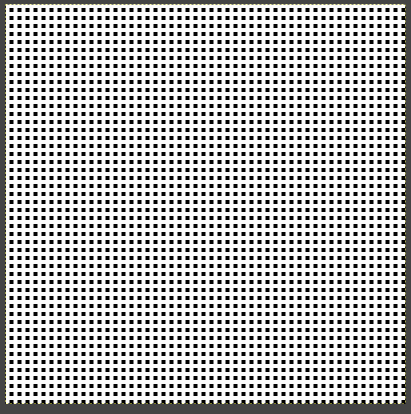 Change the white color to alpha in the previously processed snowflake, click on the rectangle tool again
Change the white color to alpha in the previously processed snowflake, click on the rectangle tool again 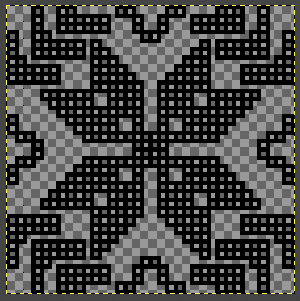 copy and paste the file onto the color-reversed grid, and click on the rectangle tool. Check the pasted image visually, and continue adding any other designs.
copy and paste the file onto the color-reversed grid, and click on the rectangle tool. Check the pasted image visually, and continue adding any other designs. 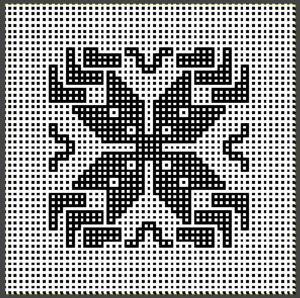 If the goal is to produce an all-over design, crop the shape on the dotted ground, and save it as a 69X69 repeat. Pasting the original on an equal-sized color reversed dotted ground does not work.
If the goal is to produce an all-over design, crop the shape on the dotted ground, and save it as a 69X69 repeat. Pasting the original on an equal-sized color reversed dotted ground does not work.  Tiling the result of the cropped repeat will show the need for cropping it by one row at the top and one column to the right.
Tiling the result of the cropped repeat will show the need for cropping it by one row at the top and one column to the right.  The resulting repeat, 68X68
The resulting repeat, 68X68  tiled X3 in each direction for a visual check.
tiled X3 in each direction for a visual check.  Using the process previously described
Using the process previously described
1. open the 68-stitch file in Gimp, and magnify it to at least 800X for a visible grid
2. open file/new, equal size and magnification
3. copy and paste 1 on 2, click on the rectangle select tool
Colors/invert, click again on the rectangle tool or anywhere in the work window 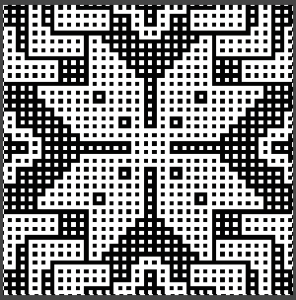 4: magnify further if needed. Using the pencil tool fill in every other row beginning with row 2 in a contrasting palette color, and click on the rectangle tool
4: magnify further if needed. Using the pencil tool fill in every other row beginning with row 2 in a contrasting palette color, and click on the rectangle tool  5. Layer, transparency, color to alpha, as described in the last post, click on rectangle tool
5. Layer, transparency, color to alpha, as described in the last post, click on rectangle tool 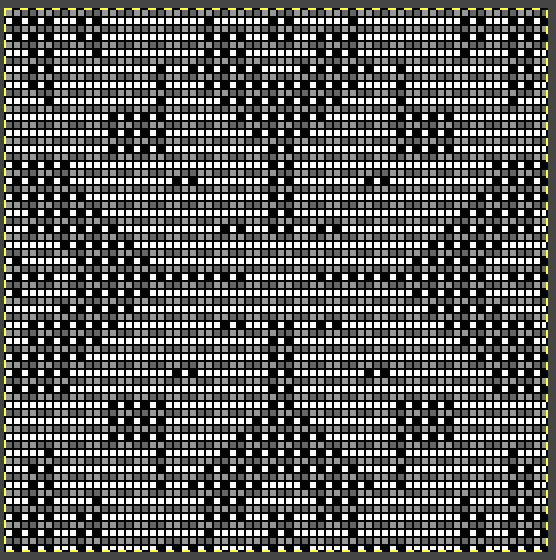 6. Copy and paste this result onto the 68-stitch file in the first window, there will be lots of dotted lines onscreen
6. Copy and paste this result onto the 68-stitch file in the first window, there will be lots of dotted lines onscreen  Click on the rectangle select tool to paste the image in place.
Click on the rectangle select tool to paste the image in place. 
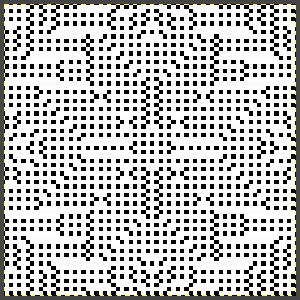 Since those large areas of white will be knitted in a tuck or slip fabric, the above result needs to be color inverted. If used as is, set the machine’s built-in double-length function.
Since those large areas of white will be knitted in a tuck or slip fabric, the above result needs to be color inverted. If used as is, set the machine’s built-in double-length function. 
 Doubling the length of the file before the download to km
Doubling the length of the file before the download to km  Added info on the technique may be found in the post on More separations for various knits using Gimp, color to alpha
Added info on the technique may be found in the post on More separations for various knits using Gimp, color to alpha
Another approach with sequential files provided to test in DIY experiments  begin with the 68X68 image
begin with the 68X68 image  color invert it
color invert it  open a new file, 2 rows high with an added color, and save it to the clipboard, white color to alpha
open a new file, 2 rows high with an added color, and save it to the clipboard, white color to alpha ![]() use the brush to fill the color inverted image,
use the brush to fill the color inverted image,  red color to alpha
red color to alpha  and paste the resulting image on the original
and paste the resulting image on the original double the file in length for knitting as mosaic, results matching the previous experiment
double the file in length for knitting as mosaic, results matching the previous experiment  Part of the view on the img2track screen for the 68X136 file is ready for download.
Part of the view on the img2track screen for the 68X136 file is ready for download.  Committing to proving the concept:
Committing to proving the concept:  Inspiration drawn from a published design, color-separating the repeat as seen in ArahPaint in knit design 6: color separations
Inspiration drawn from a published design, color-separating the repeat as seen in ArahPaint in knit design 6: color separations
 The full repeat is 100 stitches X 200 rows. The yarns are 2/8 wools, the maximum thickness for tuck stitch on a 4.5mm machine.
The full repeat is 100 stitches X 200 rows. The yarns are 2/8 wools, the maximum thickness for tuck stitch on a 4.5mm machine.
The swatch, knit on 61 stitches and for 109 rows, measures 10.25X16.5 inches. The dark loops on the side were due to yarn being caught on gate pegs, the few spots on the knit side that may appear as errors are light color stitches that did not knit off properly due to that fact.  Knitting the original design as DBJ using the built-in KRC function and the birdseye setting to produce a flat knit with “no floats” is possible.
Knitting the original design as DBJ using the built-in KRC function and the birdseye setting to produce a flat knit with “no floats” is possible.
An even number of needles must be used on the ribber.
The first preselection row is made from left to right, the knit carriage is set to slip in both directions before continuing to knit from the right. The ribber is also set to slip in both directions, using lili buttons.
The patterning errors in the swatch result from needles with bent latches, posing a strong argument for always testing a design at least once at a minimum of the full width before committing to a final piece. 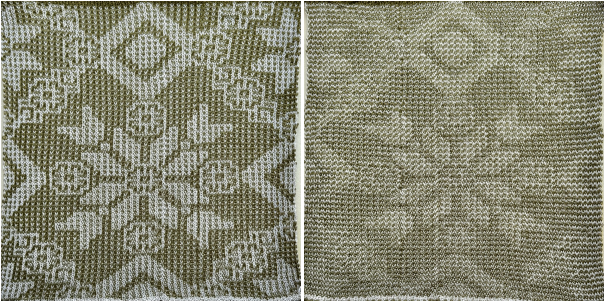
Large-scale mosaics can be planned by tripling the size of a previously tested pattern
1. the original 12X18 ![]() 2. is tripled in height and width X3 to 36X54.
2. is tripled in height and width X3 to 36X54.![]() To begin with, the process involves using multiple colors.
To begin with, the process involves using multiple colors.
Working in ArahPaint, save 2 brushes, each 2X2 pixels 3. 36X54 new image in a new window is filled with the bottom brush
3. 36X54 new image in a new window is filled with the bottom brush![]() 4. the black and white #2 is copied and pasted in place on #3 after rendering the black color transparent
4. the black and white #2 is copied and pasted in place on #3 after rendering the black color transparent ![]() 5. in a new window fill a new 36X54 image with the top bush
5. in a new window fill a new 36X54 image with the top bush ![]() 6. copy and paste #4 on #5 after rendering the white transparent
6. copy and paste #4 on #5 after rendering the white transparent ![]() check tiling
check tiling  7. convert the color repeat to BW indexed
7. convert the color repeat to BW indexed ![]()
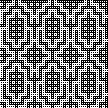 The patterns at this stage of the process may be knit double-bed as DBJ using the birdseye backing, as already shown, or as a “fantasy fair isle” with no further separation.
The patterns at this stage of the process may be knit double-bed as DBJ using the birdseye backing, as already shown, or as a “fantasy fair isle” with no further separation.
Download the repeat on an electronic machine, program it for the number of needles in use on the top bed, and select the KRC separation button.
The first preselection row is made from left to right.
After the carriages have reached the right, the main bed is set to tuck in both directions, the ribber to N in both directions.
Because the fabric is being knit using every needle on both beds, each main bed tuck loop will have a knit stitch on the opposite bed anchoring it down. Those rows will appear more compressed, producing narrower horizontal lines.
The knit is reversible, wide, and drapes well.
I recommend starting double bed fabrics with waste yarn and ravel cord, testing color changes, and checking that stitches are formed properly.
I missed several dropped stitches at the start of this piece, in areas marked with cyan arrows.
Because ribber fabrics sit hiding between the beds, dropped stitches or patterning errors may not be seen until several inches of fabric have been knit.
The test swatch, knit on 72 stitches, and testing partial repeat height, measures 17.5 inches in width.  Performing the color separation for knitting the design in the traditional single-bed method
Performing the color separation for knitting the design in the traditional single-bed method
the starting file ![]() color-inverted
color-inverted ![]() new file, stripe brush-filled
new file, stripe brush-filled 
![]() copy and paste it on the color reversed image after rendering the purple transparent
copy and paste it on the color reversed image after rendering the purple transparent ![]() copy and paste the result on the original file after rendering cyan transparent,
copy and paste the result on the original file after rendering cyan transparent, ![]() double the result in length, 36X108
double the result in length, 36X108![]()
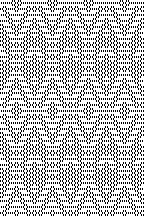 color invert, the 36X108 file, check that it is in indexed BW mode before saving.
color invert, the 36X108 file, check that it is in indexed BW mode before saving.
![]() The proof-of-concept swatch uses the tuck setting. It was knit using 2/8 wool on 72 stitches X 120 rows and measures 10.5X11.75 inches.
The proof-of-concept swatch uses the tuck setting. It was knit using 2/8 wool on 72 stitches X 120 rows and measures 10.5X11.75 inches.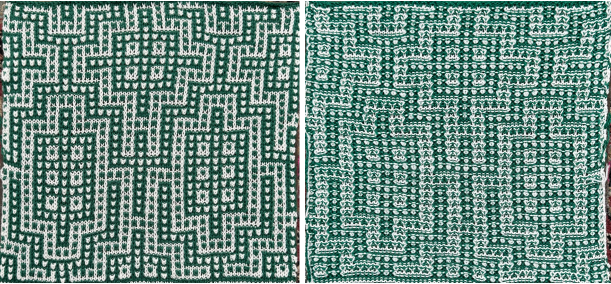
A file creating different shapes to play with, 32X86![]() tiled as is
tiled as is 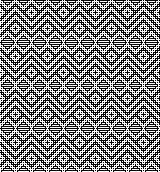 color reversed
color reversed 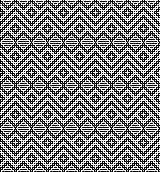 For color separation see ArahPaint in knit design 6
For color separation see ArahPaint in knit design 6
The final repeat, 32X172 rows ![]() The test swatch was knit on 60 stitches and for 182 rows, measured 9X11.25 inches
The test swatch was knit on 60 stitches and for 182 rows, measured 9X11.25 inches  A larger BW design was processed using no modification of the original 75X71 motif. When using Gimp/File/Save, the result is a .xcf document similar to PSD files in Photoshop. It will store layers, transparency settings, and more information associated with and parts of the same project.
A larger BW design was processed using no modification of the original 75X71 motif. When using Gimp/File/Save, the result is a .xcf document similar to PSD files in Photoshop. It will store layers, transparency settings, and more information associated with and parts of the same project. 
 Note to self: before deleting the .xcf, ensure the final PNG has been saved.
Note to self: before deleting the .xcf, ensure the final PNG has been saved.
If determined to use the particular flower, the starting file 96X90 is copied and pasted on a new brush-filled ground with the black rendered transparent, adjusting placement, cleaning up edges
is copied and pasted on a new brush-filled ground with the black rendered transparent, adjusting placement, cleaning up edges  a new color is used to outline the outer shape of the flower and the petals for better definition
a new color is used to outline the outer shape of the flower and the petals for better definition  it is copied and pasted on a new brush-filled ground after the white is rendered transparent
it is copied and pasted on a new brush-filled ground after the white is rendered transparent  the colors converted to BW, playing with placement in any final piece
the colors converted to BW, playing with placement in any final piece

A May 2025 experiment
The image on the left is from Atwater, Mary Meigs, How to Weave on the Inkle Loom. My adaptation began in a spreadsheet. The yellow outline served as a mask to keep the brush fill for the dotted ground from touching the edges of the design. Lastly, the first character was mirrored to include a dancing partner.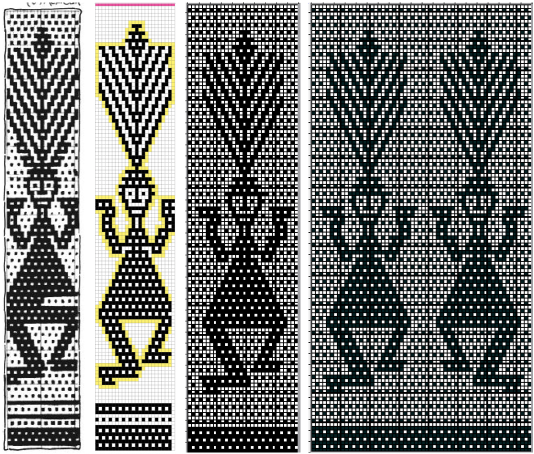 The smallest repeat, 30X122
The smallest repeat, 30X122 ![]() mirrored, 69X22
mirrored, 69X22 tiled to 180 pixels in width, the maximum whole repeat on the needle bed
tiled to 180 pixels in width, the maximum whole repeat on the needle bed 1. the original mirrored image
1. the original mirrored image
2. color reversed 3. the same size image filled with a 2 row, 2 color brush
3. the same size image filled with a 2 row, 2 color brush
 4. copied and pasted onto the color reversed image, 2, after rendering the bottom row color to alpha/ transparent
4. copied and pasted onto the color reversed image, 2, after rendering the bottom row color to alpha/ transparent  5. 4 copied and pasted on the original, 1, after rendering the second row color transparent
5. 4 copied and pasted on the original, 1, after rendering the second row color transparent  6. the result color reversed for the first step in knitting using slip stitch setting with color changes every 2 rows
6. the result color reversed for the first step in knitting using slip stitch setting with color changes every 2 rows
 The last image needs to be lengthened X2 before downloading and knitting or used as is in combination with the double length button in some electronic models. On the 930 I chose the latter option to avoid using multiple tracks. The final double length version, 60X244
The last image needs to be lengthened X2 before downloading and knitting or used as is in combination with the double length button in some electronic models. On the 930 I chose the latter option to avoid using multiple tracks. The final double length version, 60X244 The proof of concept
The proof of concept So easy to imagine the color inverted model, no knitting necessary
So easy to imagine the color inverted model, no knitting necessary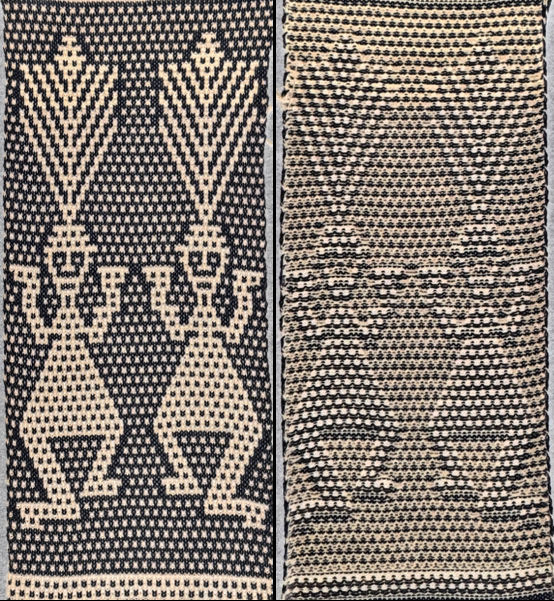
If one is familiar with image processing and fond of the maze appearance in designs, there is a font to try: Mazeletter
The downloadable associated documentation and source for inspiration: http://mazeletter.xyz/Mazeletter.pdf.
A sample text:  in a 129X32 BW version with no pixel clean-up
in a 129X32 BW version with no pixel clean-up ![]() Mosaic4way, is potentially usable for single bed fair isle or dbj.
Mosaic4way, is potentially usable for single bed fair isle or dbj.  The BW file, 199X32
The BW file, 199X32
![]() When scaling designs containing more than 2 colors, there is a variable loss of detail or added random pixels. ArahPaint’s guess weave from the grid tool is the best I have found for scaling such samples to knittable sizes.
When scaling designs containing more than 2 colors, there is a variable loss of detail or added random pixels. ArahPaint’s guess weave from the grid tool is the best I have found for scaling such samples to knittable sizes.
Fantasy fair isle is a double bed technique that can produce knits that are reversible and have a gridded structure remindful of single bed mosaic knitting

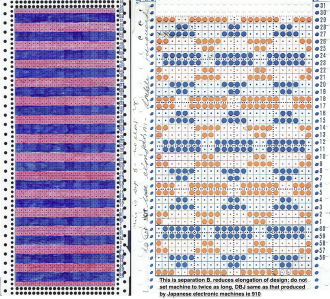
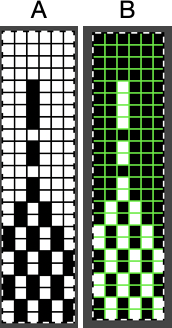

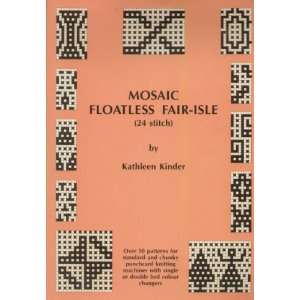


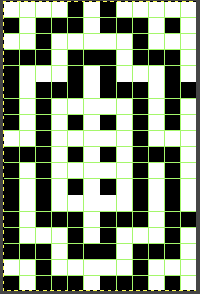
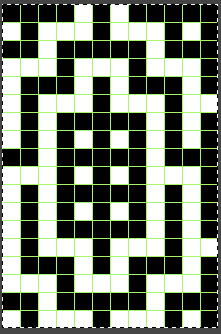
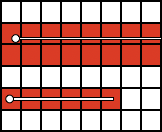


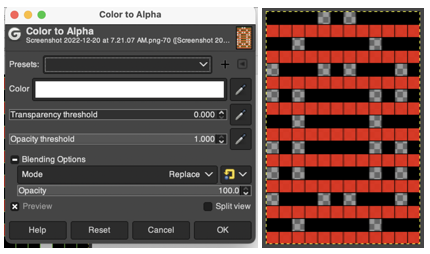


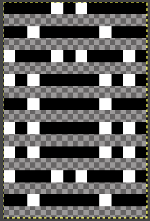
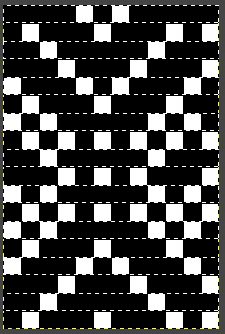

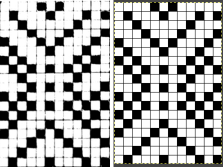
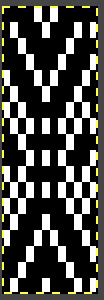
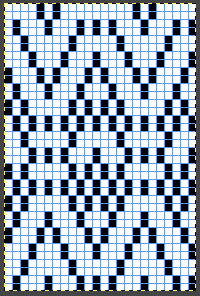





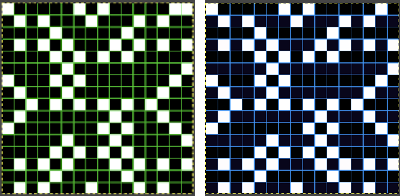
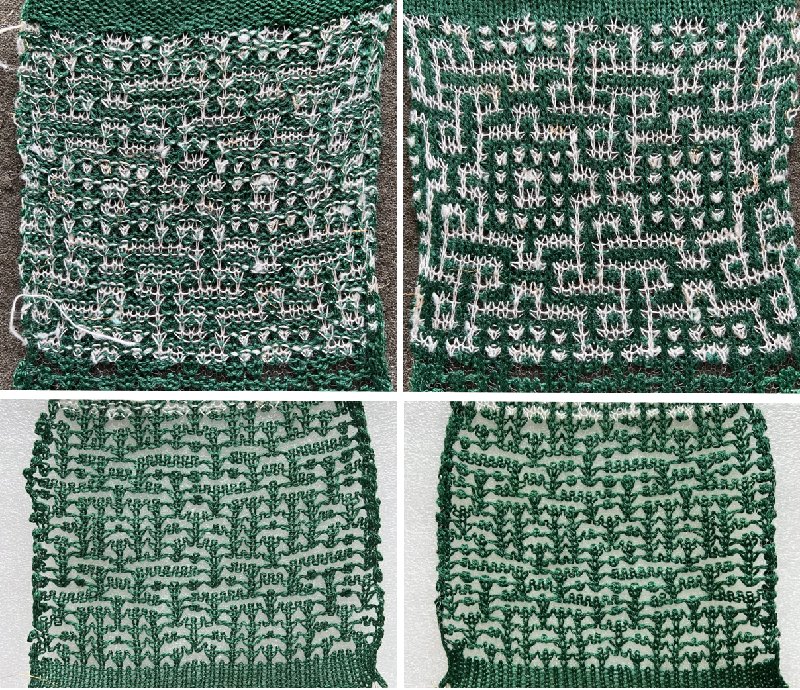


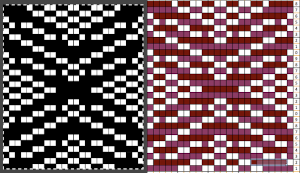 repeating the process described here, it took longer to render the repeat than to perform the color separation. The tiled alignment check
repeating the process described here, it took longer to render the repeat than to perform the color separation. The tiled alignment check

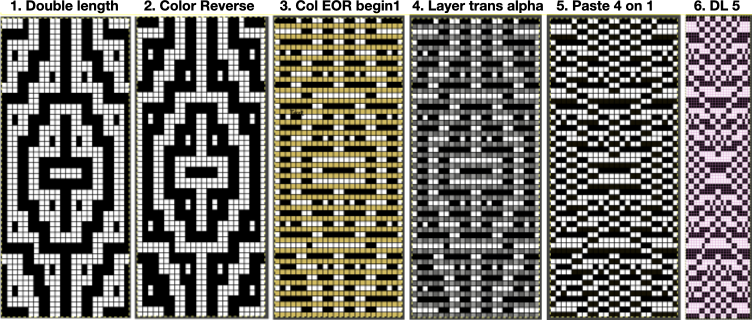

 Duplicating the result using layer/ transparency
Duplicating the result using layer/ transparency 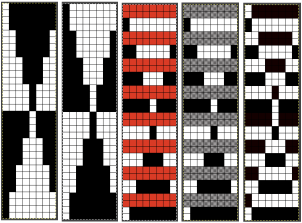

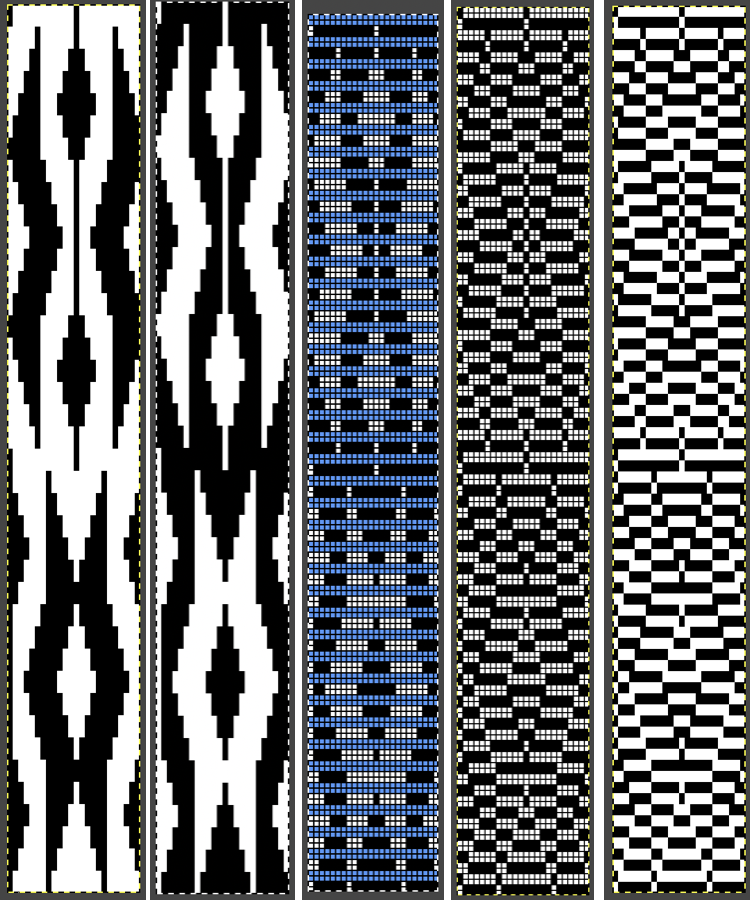




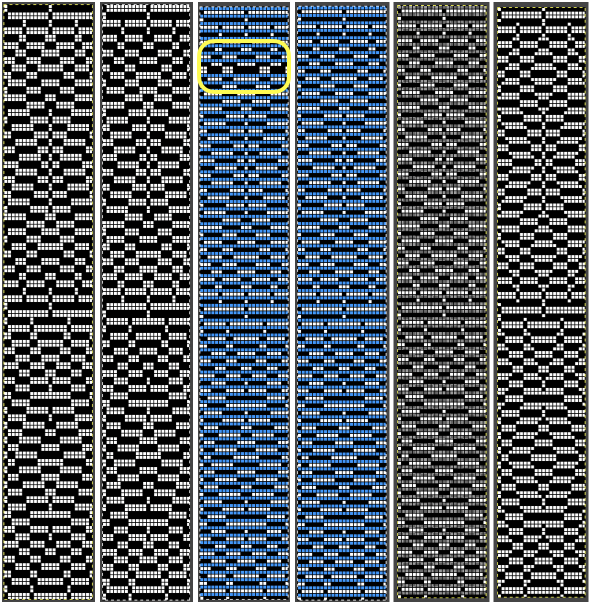

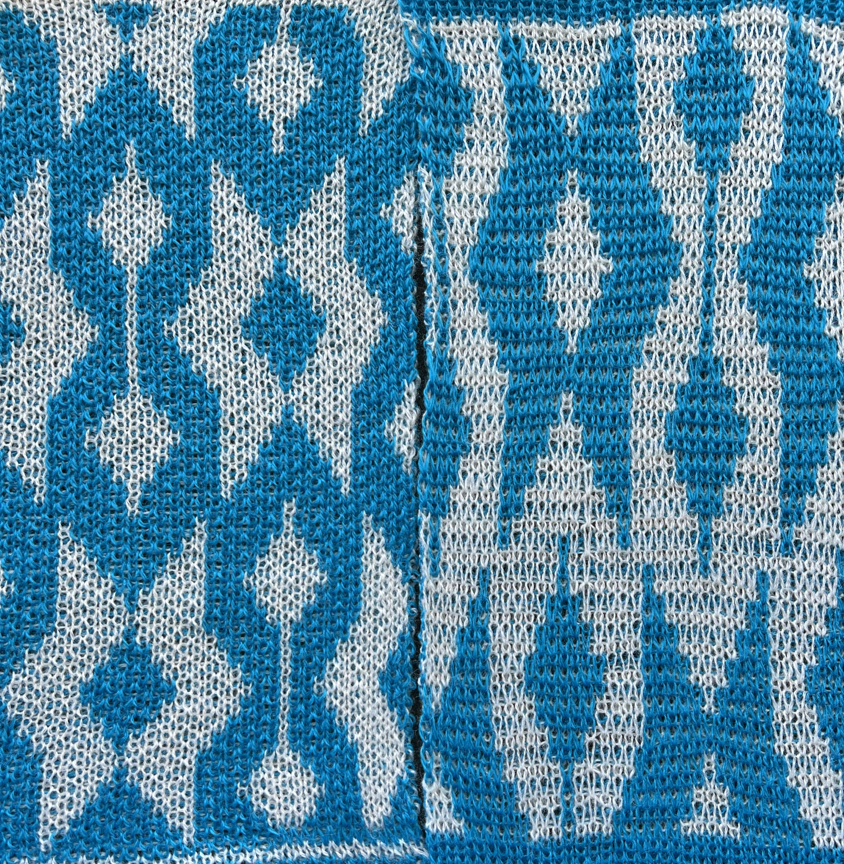

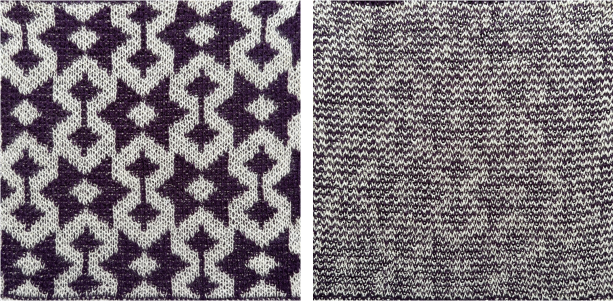

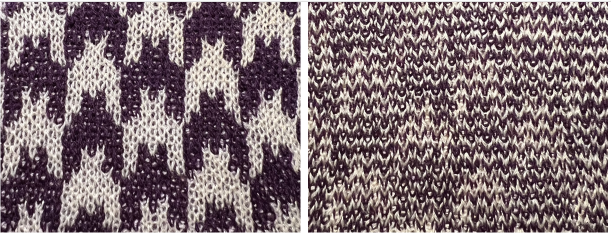





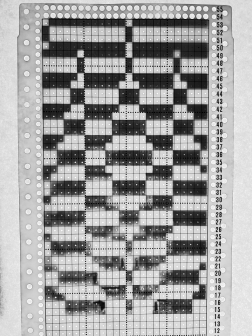
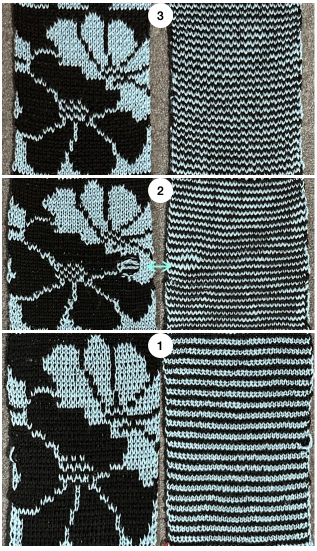






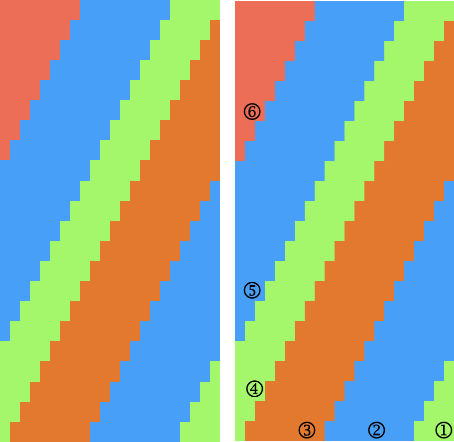
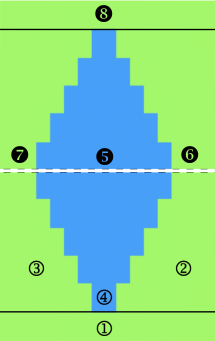
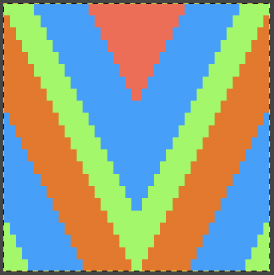
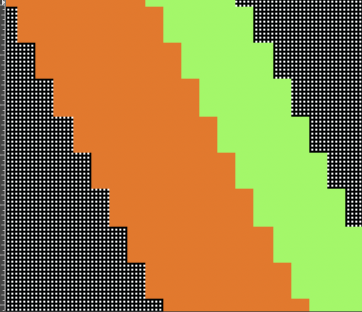

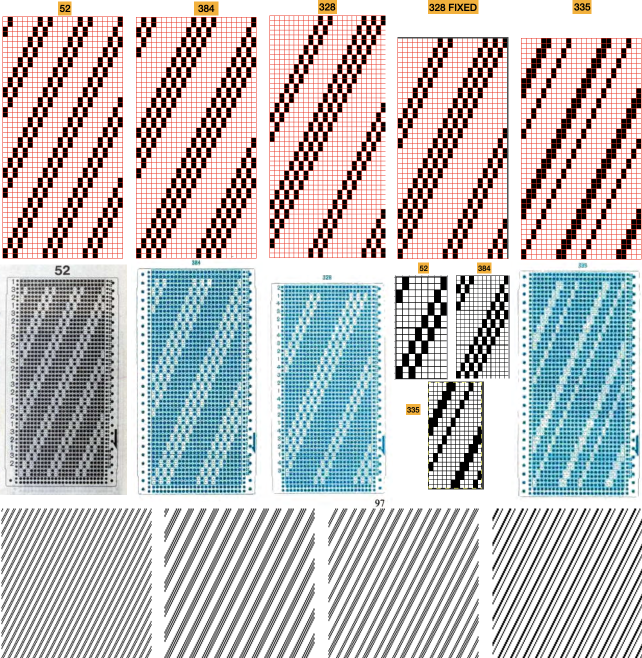
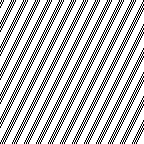
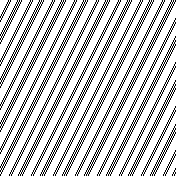
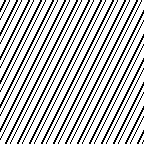

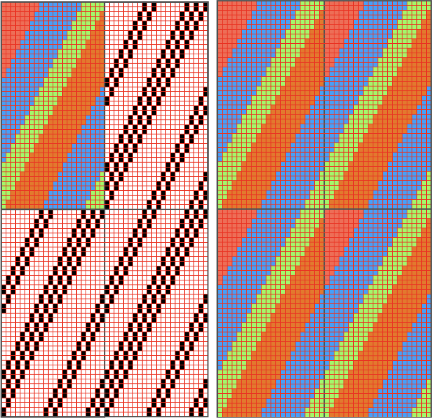

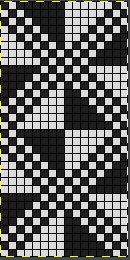

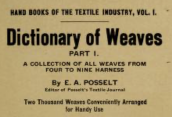
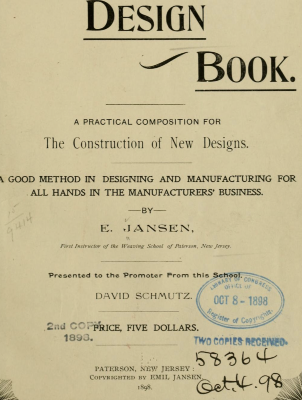



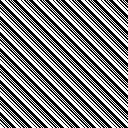
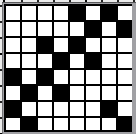

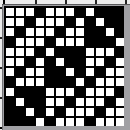



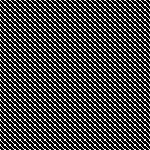
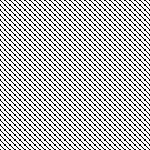



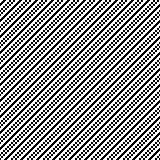
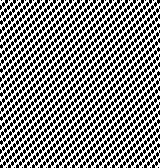
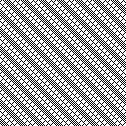



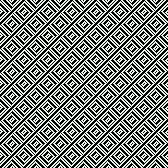
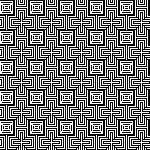
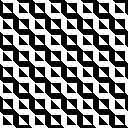

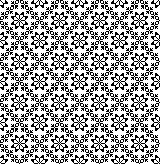
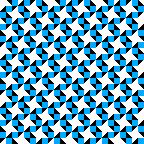

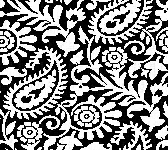
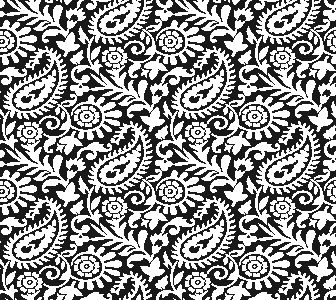


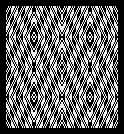



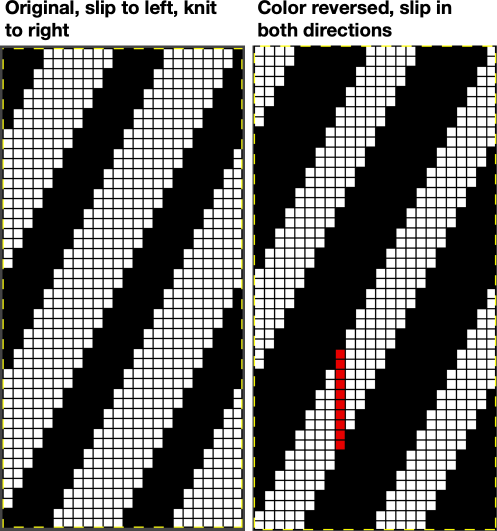

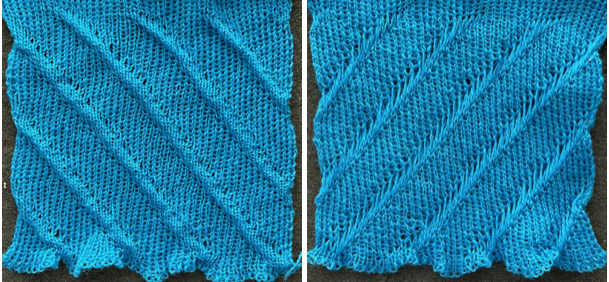


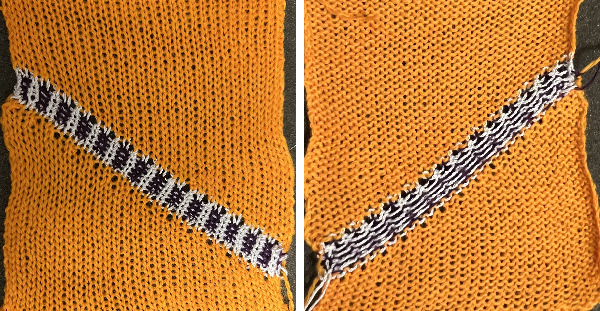
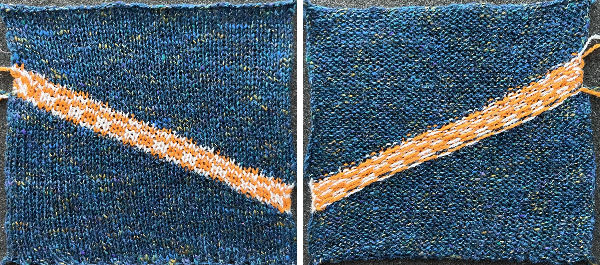

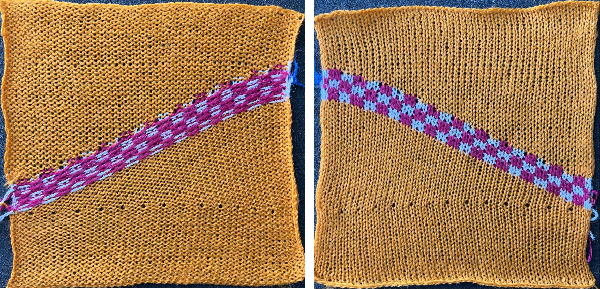

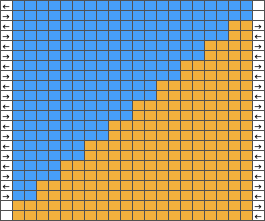
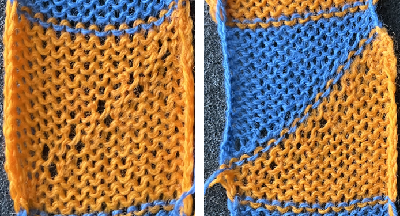
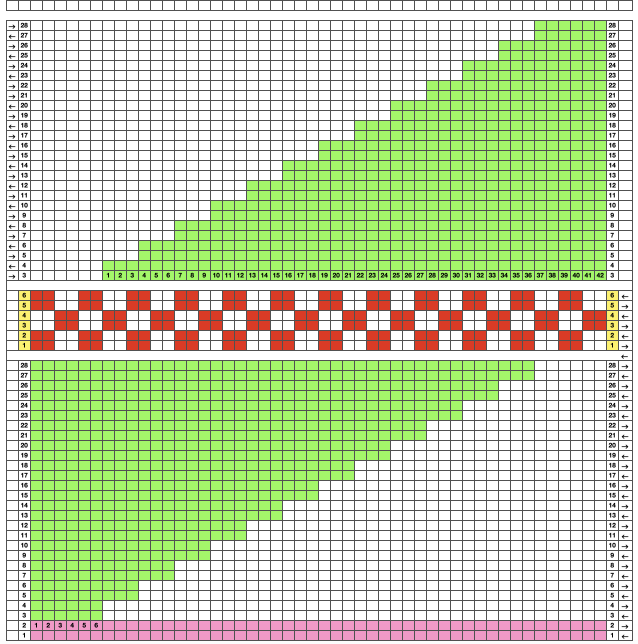
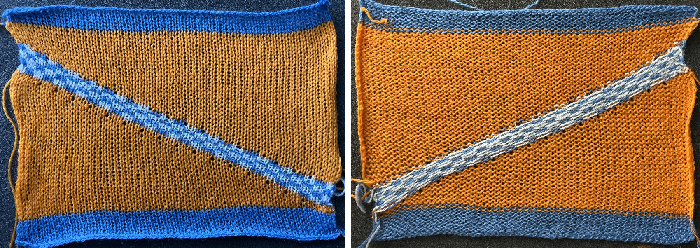


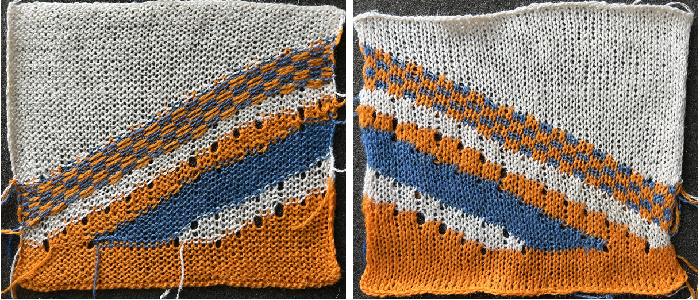





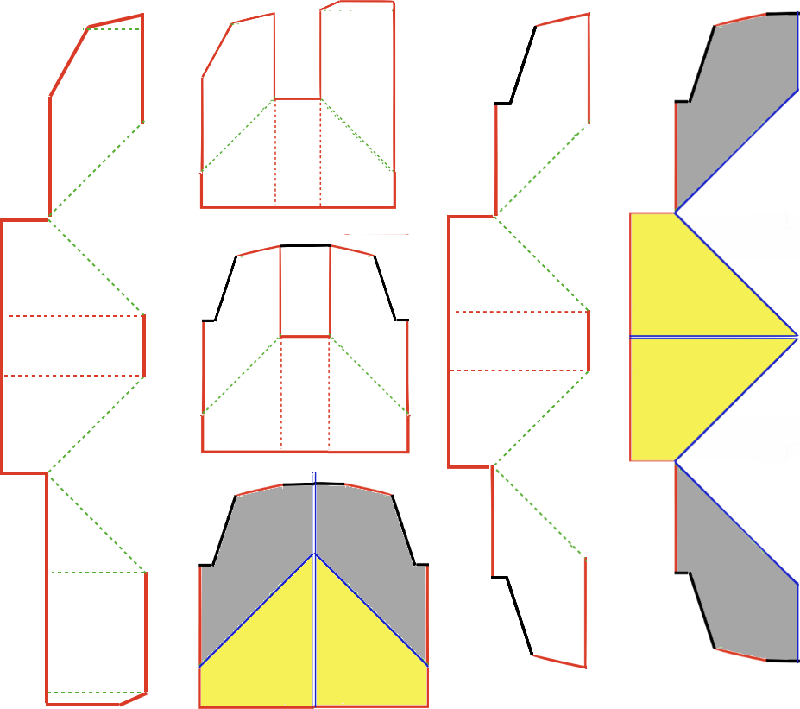

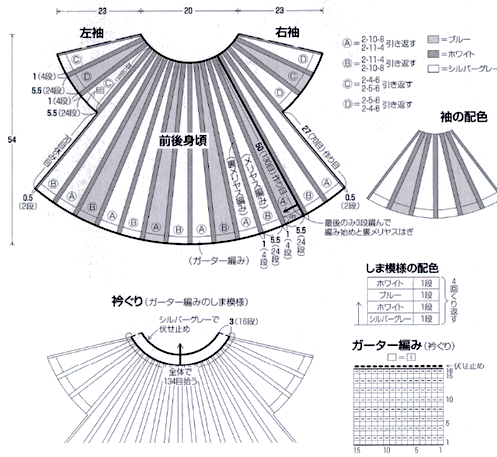

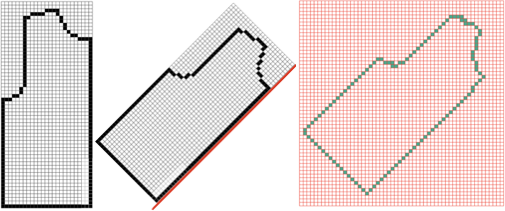
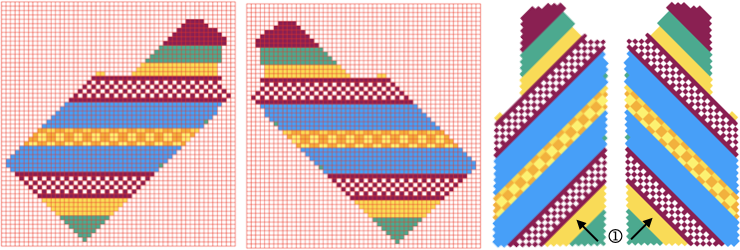
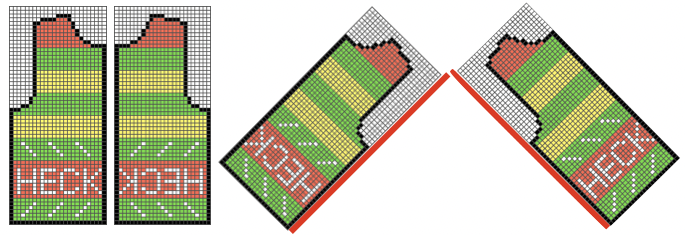
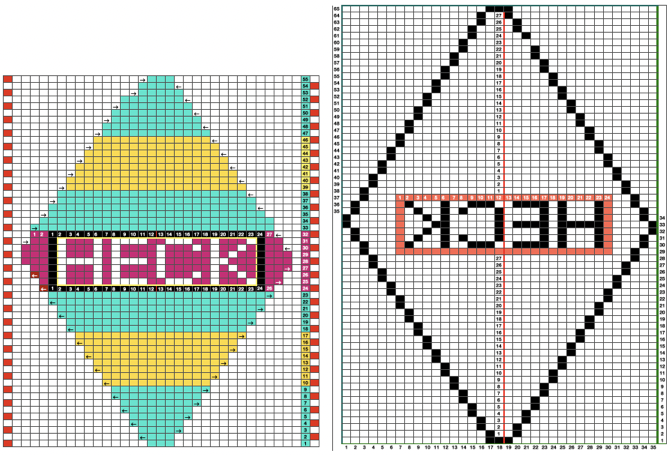
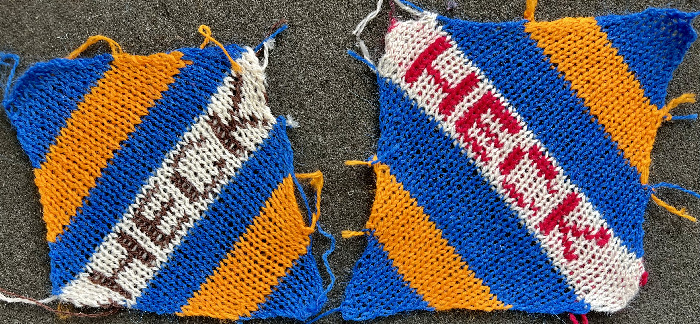
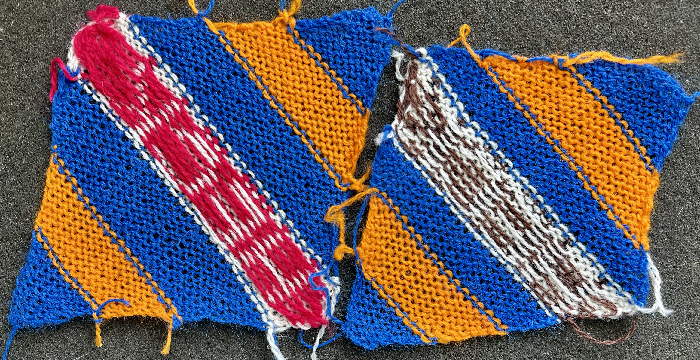

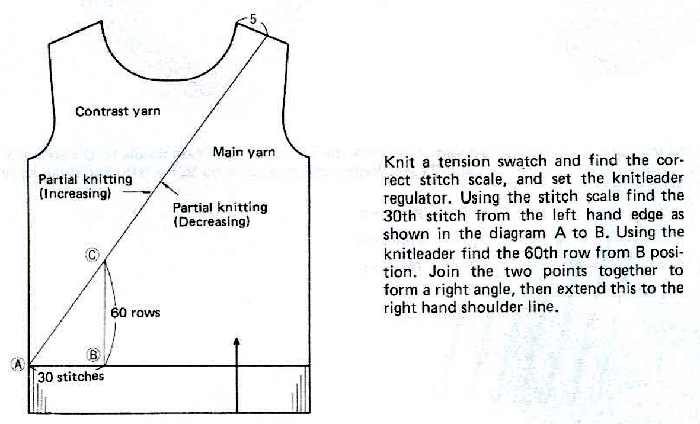
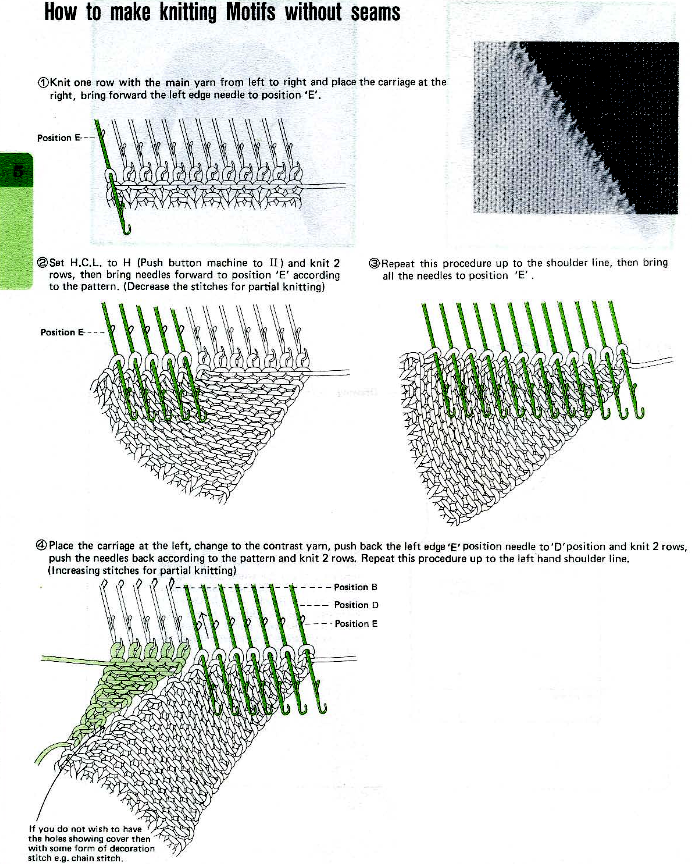

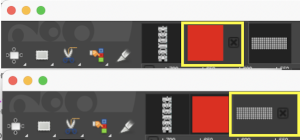
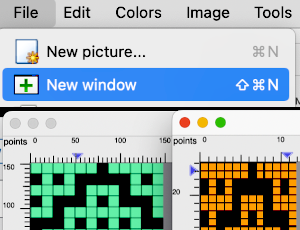



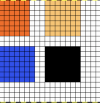




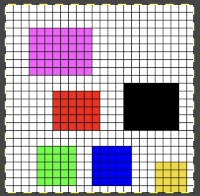





 Designing for fair isle, or when attempting to visualize and illustrate slip and tuck fabrics with frequent color changes, more colors may be required even though the final download will be in black and white. There is a quick way to add random colors assigned by the program and based on the initial palette:
Designing for fair isle, or when attempting to visualize and illustrate slip and tuck fabrics with frequent color changes, more colors may be required even though the final download will be in black and white. There is a quick way to add random colors assigned by the program and based on the initial palette: 

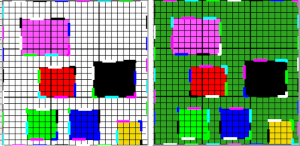




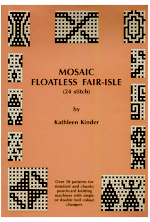
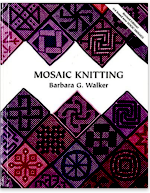

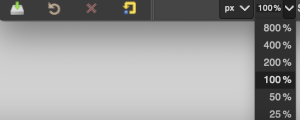




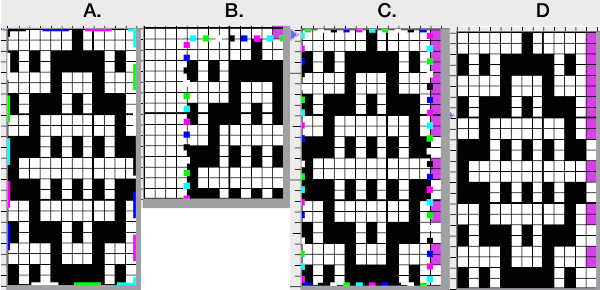



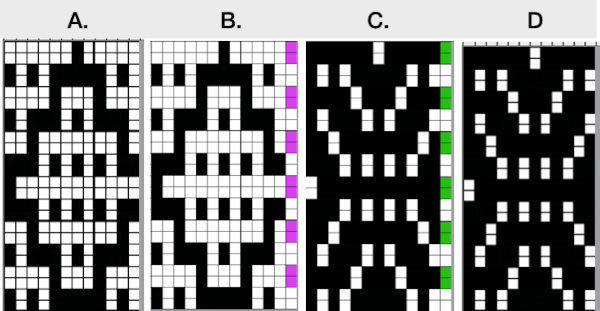
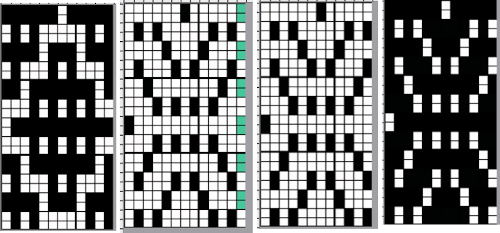












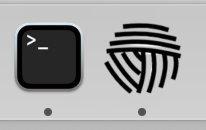
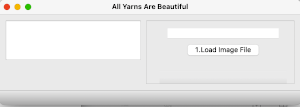
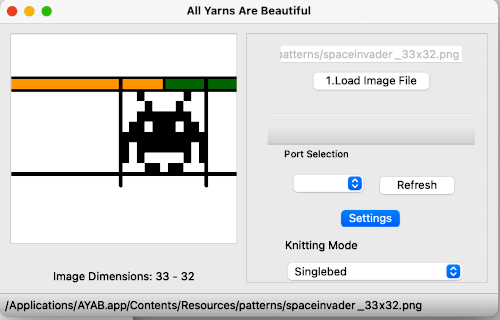

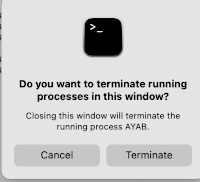

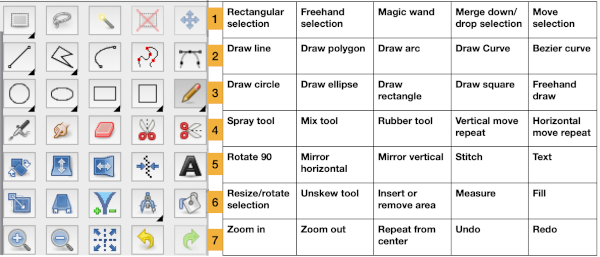


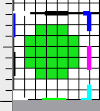


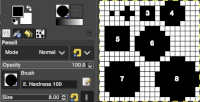
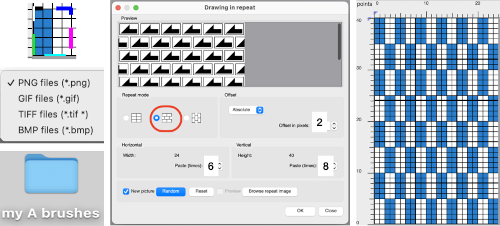



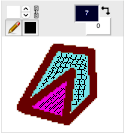














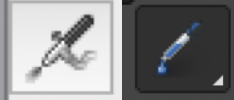




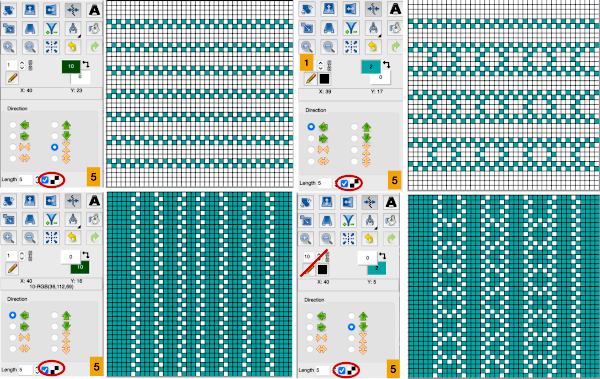


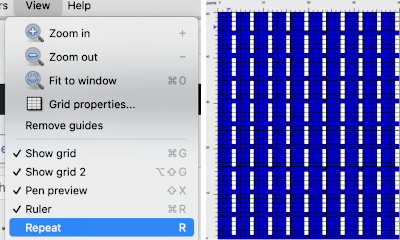
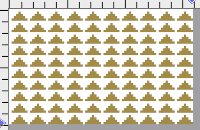
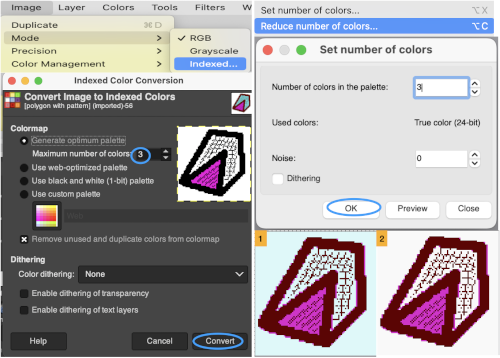


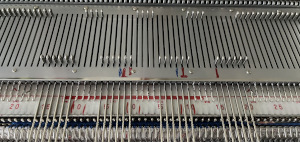


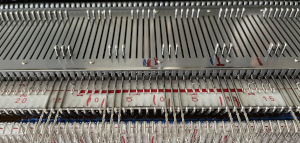

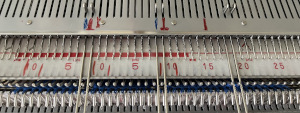


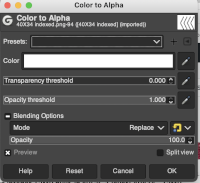
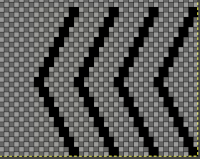

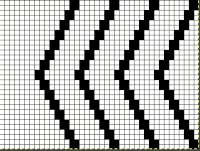
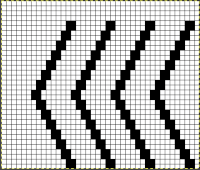








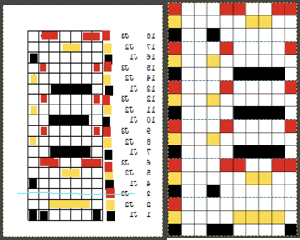

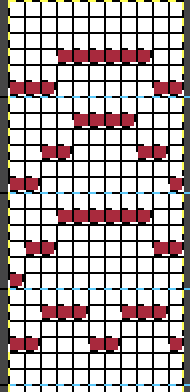

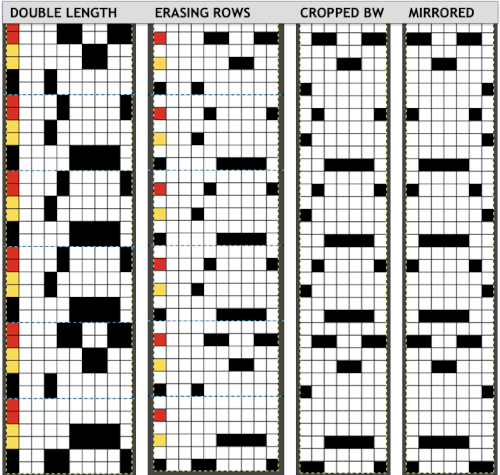
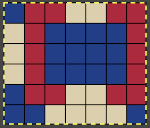
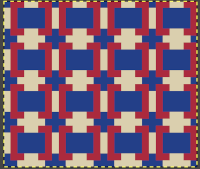

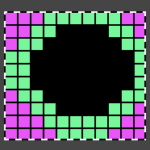 Here it is shown modified, with rows containing fewer than 3 colors marked.
Here it is shown modified, with rows containing fewer than 3 colors marked. 




 The repeats for designs may be self-separated to suit.
The repeats for designs may be self-separated to suit.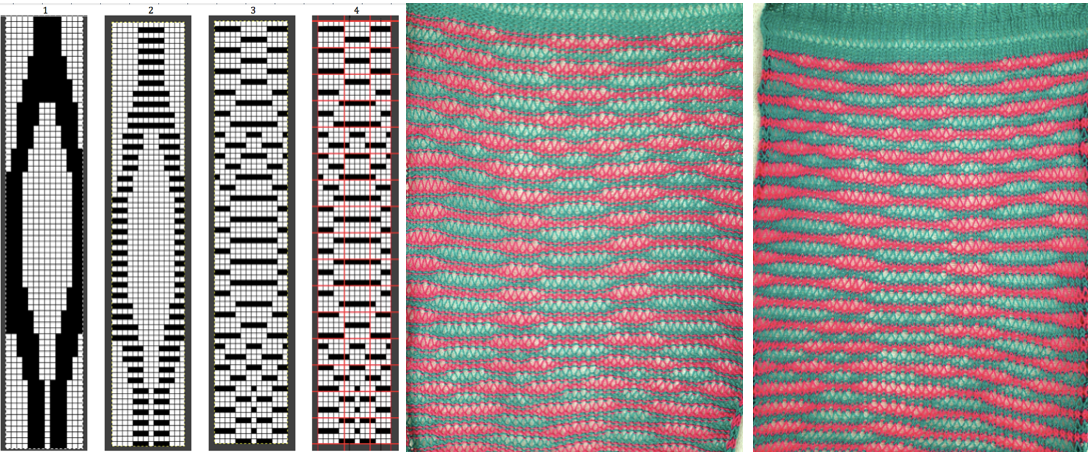
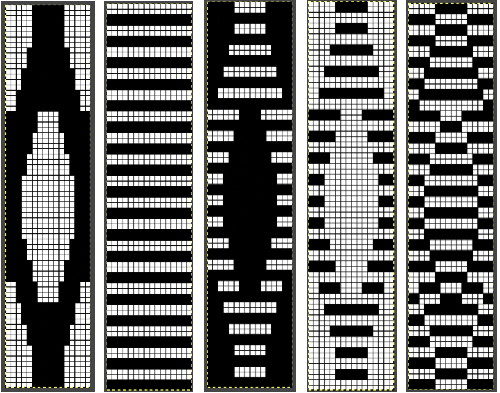 Three variations of the final png files are shared
Three variations of the final png files are shared  This is the appearance when a different design was entered in img2track. The separated file 3 color file in BW is not shared.
This is the appearance when a different design was entered in img2track. The separated file 3 color file in BW is not shared.  The method for knitting the pattern: the long stitches are formed by loops that are created on the top bed and dropped on the following row.
The method for knitting the pattern: the long stitches are formed by loops that are created on the top bed and dropped on the following row.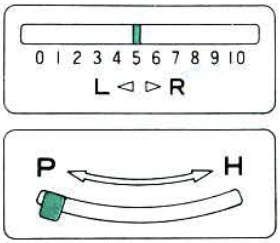


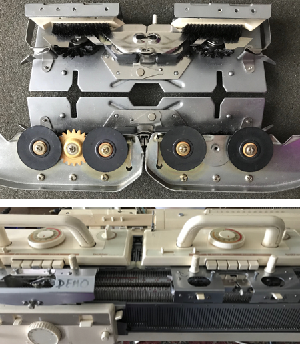
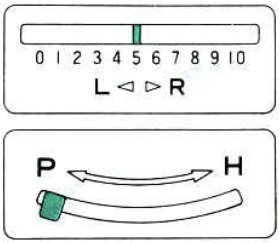
 The second carriage, C2 is set to KCII as well. It will be advancing the design with each pass as well and will drop loops on the first pass, preselect for the subsequent pattern row on the next
The second carriage, C2 is set to KCII as well. It will be advancing the design with each pass as well and will drop loops on the first pass, preselect for the subsequent pattern row on the next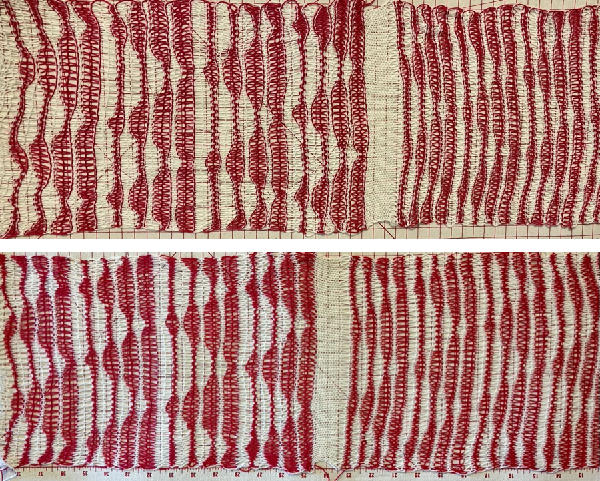
 The elongated stitches allow objects behind them to peek through
The elongated stitches allow objects behind them to peek through 

 Here the goal is to use the img2 track separation, maintaining the same color change rotation in each piece.
Here the goal is to use the img2 track separation, maintaining the same color change rotation in each piece.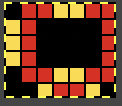
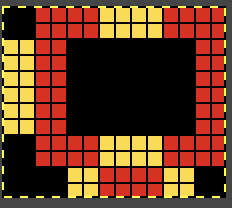
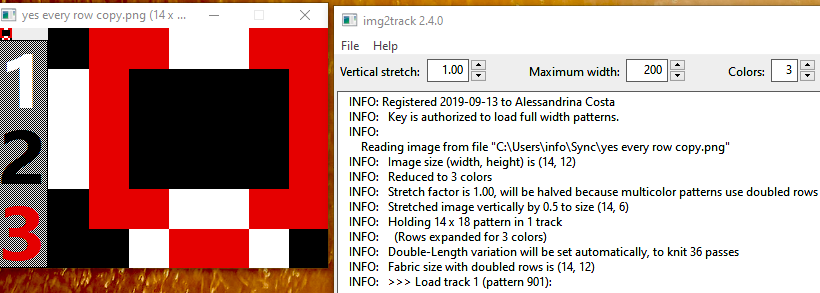 The tiled potential appearance as a dbj fabric:
The tiled potential appearance as a dbj fabric: In the first sample three carriages are used:
In the first sample three carriages are used: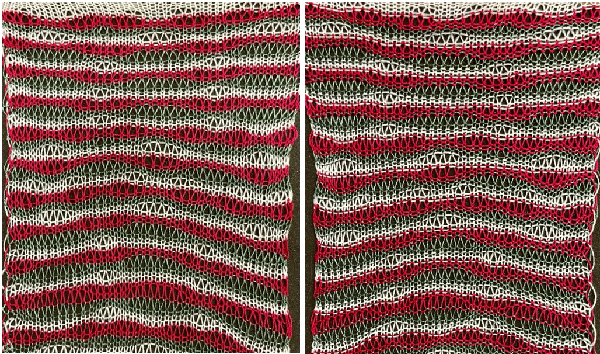 What of end release? because all 3 colors are present in every row, the design is suitable. The first preselection row is from right to left.
What of end release? because all 3 colors are present in every row, the design is suitable. The first preselection row is from right to left.
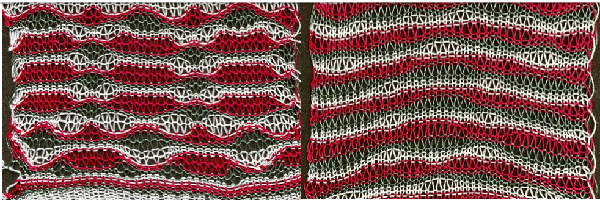

 Any published or self-drawn separation for 3 colors per row patterning including every color in every row of the original design may be used, programmed as a single bed design, and knit for end release.
Any published or self-drawn separation for 3 colors per row patterning including every color in every row of the original design may be used, programmed as a single bed design, and knit for end release.


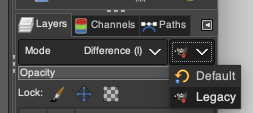


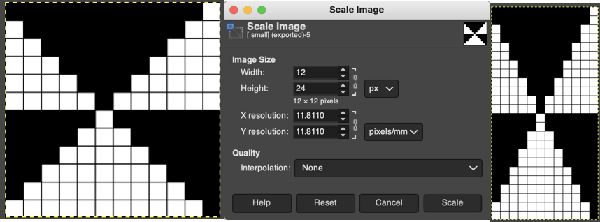 the white ground of the resulting image is rendered transparent by using Color to Alpha
the white ground of the resulting image is rendered transparent by using Color to Alpha 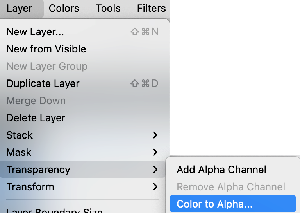
 Select New Layer from the Layers menu (see chart), choosing the background or foreground color to have a white screen. It will share properties with the alpha repeat such as pixel count, magnification, and the grid view if used.
Select New Layer from the Layers menu (see chart), choosing the background or foreground color to have a white screen. It will share properties with the alpha repeat such as pixel count, magnification, and the grid view if used.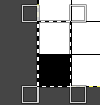 Copy the selection, and it will be saved to the clipboard and remain available for filling with the pattern unless the program is quit. It may also be
Copy the selection, and it will be saved to the clipboard and remain available for filling with the pattern unless the program is quit. It may also be 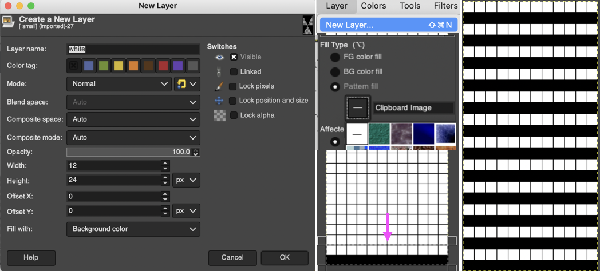 In the layers dialogue, use the mouse to drag and drop the alpha image icon for the triangle layer onto the newly created one. The selected icon will appear surrounded by a border when chosen, a new icon will appear during the step.
In the layers dialogue, use the mouse to drag and drop the alpha image icon for the triangle layer onto the newly created one. The selected icon will appear surrounded by a border when chosen, a new icon will appear during the step. 
 Color invert the new image
Color invert the new image  Click on the downward pointer to the right of Normal and select Difference. The result is a repeat that may then be saved and used doubled in height to knit DBJ in a variety of settings.
Click on the downward pointer to the right of Normal and select Difference. The result is a repeat that may then be saved and used doubled in height to knit DBJ in a variety of settings.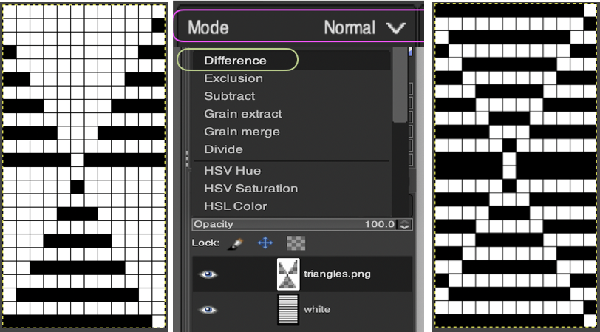 Elongation after download can be avoided by working with the same initial image scaled in height X4 and following the same process, saving and using the repeat on the far right.
Elongation after download can be avoided by working with the same initial image scaled in height X4 and following the same process, saving and using the repeat on the far right. 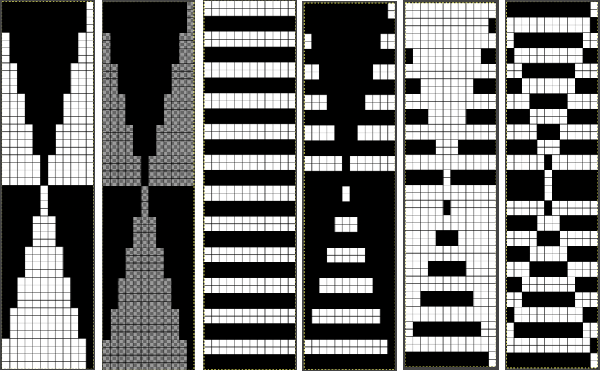 The same separation was achieved using other methods in the post on fantasy fair isle.
The same separation was achieved using other methods in the post on fantasy fair isle.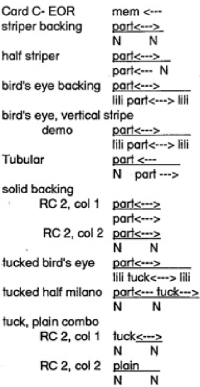 Are punchcard knitters left out? In the
Are punchcard knitters left out? In the 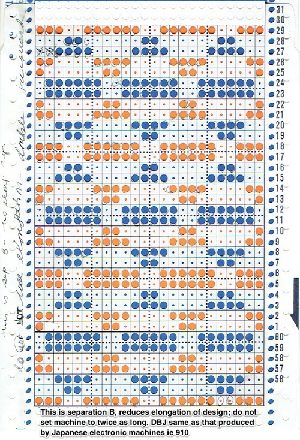 and the starting design shown with the color reversed repeat of the above.
and the starting design shown with the color reversed repeat of the above. 
 When a color separation is downloaded it is used as one would a fair isle. If the motif is representational and direction on the knit side matters, any repeats may have to be mirrored horizontally if they are automatically reversed by either your software prior to download or your machine model after it.
When a color separation is downloaded it is used as one would a fair isle. If the motif is representational and direction on the knit side matters, any repeats may have to be mirrored horizontally if they are automatically reversed by either your software prior to download or your machine model after it.


 The image is processed as for the previous separation, the final png is exported. Open the saved in Gimp.
The image is processed as for the previous separation, the final png is exported. Open the saved in Gimp.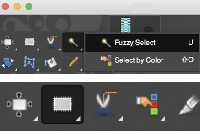 Using the rectangle tool, select a single blue row, after the selection, press and hold down the shift key and repeat selections of multiple rows in the same color. Each selection will be bordered by a dotted line.
Using the rectangle tool, select a single blue row, after the selection, press and hold down the shift key and repeat selections of multiple rows in the same color. Each selection will be bordered by a dotted line.  Release the shift key. Click on the rectangle select tool and then again in the work window outside the image to set it. The dotted lines will disappear. The same action is repeated if working on segments of the full file at a time.
Release the shift key. Click on the rectangle select tool and then again in the work window outside the image to set it. The dotted lines will disappear. The same action is repeated if working on segments of the full file at a time. The 24X72 new png
The 24X72 new png 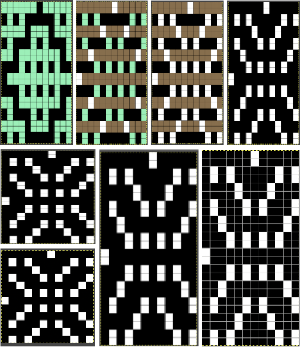 Both results require scaling X2 before knitting, whether by button setting changes in the repeat after download or in Gimp before.
Both results require scaling X2 before knitting, whether by button setting changes in the repeat after download or in Gimp before. 
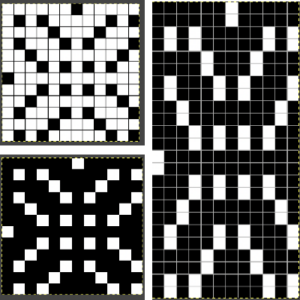
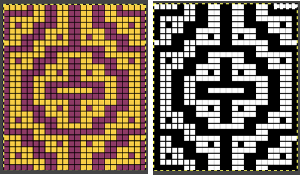
 The process in Layers
The process in Layers The very last file on the right is saved as a PNG. In turn, it is opened again in Gimp, scaled to twice its height
The very last file on the right is saved as a PNG. In turn, it is opened again in Gimp, scaled to twice its height 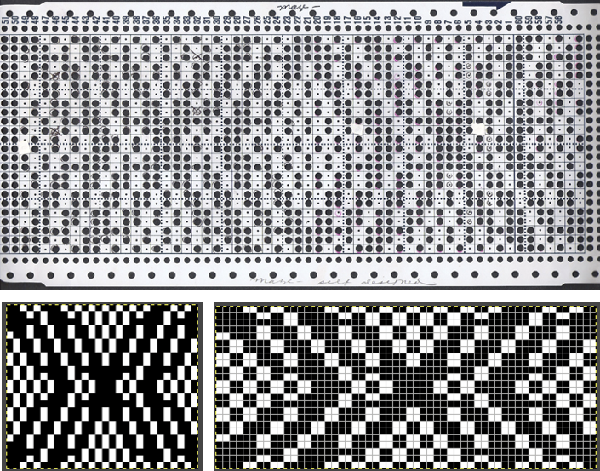 Exclusion is the alternative Layer mode which when following the same process yields identical results.
Exclusion is the alternative Layer mode which when following the same process yields identical results. 
 A block slip stitch design from the
A block slip stitch design from the 
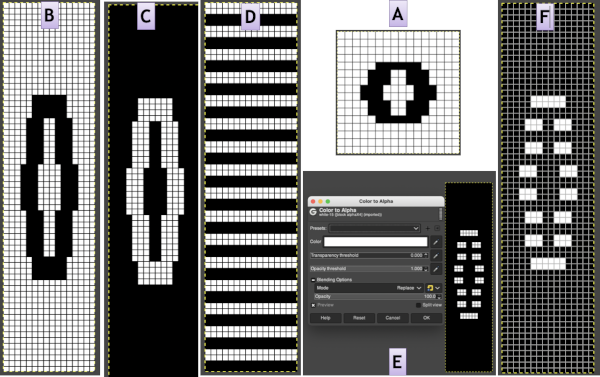




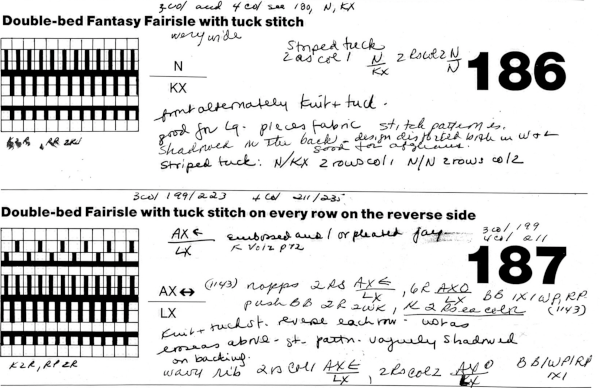 In Fantasy Fairisle knitting using 187 with alternating up and down pushers on the back bed and AX with 2 arrow keys would match Brother ribber knitting with lili buttons used on an even number of needles set to tuck.
In Fantasy Fairisle knitting using 187 with alternating up and down pushers on the back bed and AX with 2 arrow keys would match Brother ribber knitting with lili buttons used on an even number of needles set to tuck. For the 1-pixel grid in Gimp to be visible on an editable image, a magnification of at least 800 is required. The options offered by default
For the 1-pixel grid in Gimp to be visible on an editable image, a magnification of at least 800 is required. The options offered by default can be changed to suit by simply typing in a new number.
can be changed to suit by simply typing in a new number.
 the processed image
the processed image  the trimmed 98X182 png
the trimmed 98X182 png  doubled in length once more to 98X364
doubled in length once more to 98X364  Knitting process on a 930 using img2track:
Knitting process on a 930 using img2track: A reminder: in my experience, the Brother cast-on combs are usually chrome-colored, Studio grey, and Passap, and I believe Superba ones were traditionally green. The first 2 were designed for 4.5 mm machines, the latter for 5mm. The different mm spacing does not make the 5 mm combs suitable for casting on on Brother, but they can be poked through the knit in progress. I like to leave the first comb and weights on, insert the new comb closer to the beds, and then move the weight up, and then remove the lower position comb.
A reminder: in my experience, the Brother cast-on combs are usually chrome-colored, Studio grey, and Passap, and I believe Superba ones were traditionally green. The first 2 were designed for 4.5 mm machines, the latter for 5mm. The different mm spacing does not make the 5 mm combs suitable for casting on on Brother, but they can be poked through the knit in progress. I like to leave the first comb and weights on, insert the new comb closer to the beds, and then move the weight up, and then remove the lower position comb.
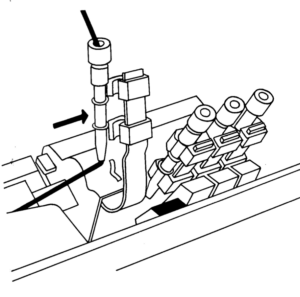 In the Brother model, sometimes the yarn is left in the wrong place below eye level rather than its own individual one corresponding to its button, and both yarns are picked up with the next color change.
In the Brother model, sometimes the yarn is left in the wrong place below eye level rather than its own individual one corresponding to its button, and both yarns are picked up with the next color change. 
 a close-up of the texture at an angle
a close-up of the texture at an angle  Claudia Scarpa developed a skull variation using only layers in Gimp
Claudia Scarpa developed a skull variation using only layers in Gimp 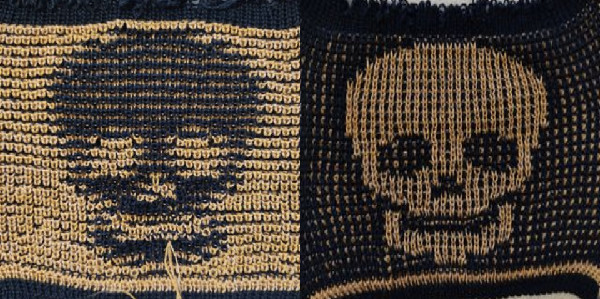 and has been kind enough to create a
and has been kind enough to create a 
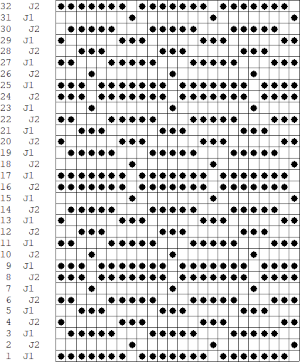
 It is possible to work some repeats on some machines with the ribber also set to tuck both ways with EON needle selection.
It is possible to work some repeats on some machines with the ribber also set to tuck both ways with EON needle selection.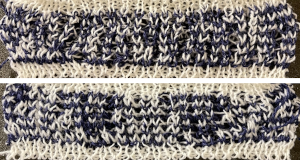 When using the Dak stitch design module, the color separation is automated. Choose any design repeat. This happens to be a 20X20 one, chosen from the thumbnail assortment, so not suitable for punchcard models. “Printing” the template using choosing the option of using dots rather than squares to represent knit stitches makes the resulting print screengrab easier to trace.
When using the Dak stitch design module, the color separation is automated. Choose any design repeat. This happens to be a 20X20 one, chosen from the thumbnail assortment, so not suitable for punchcard models. “Printing” the template using choosing the option of using dots rather than squares to represent knit stitches makes the resulting print screengrab easier to trace.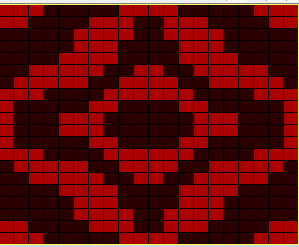 the 20X20 repeat as a BW png
the 20X20 repeat as a BW png  The result is screengrabbed, opened in Gimp, converted to BW mode, and scaled to the 20X40 expanded design size. Unless the double-length function in the machine is also used, it will need scaling again to double length prior to download.
The result is screengrabbed, opened in Gimp, converted to BW mode, and scaled to the 20X40 expanded design size. Unless the double-length function in the machine is also used, it will need scaling again to double length prior to download. The final image double length, showing the difference between the separation using the template, and that using layers as in Claudia’s video, which appears different but is actually the same repeat, color reversed.
The final image double length, showing the difference between the separation using the template, and that using layers as in Claudia’s video, which appears different but is actually the same repeat, color reversed. 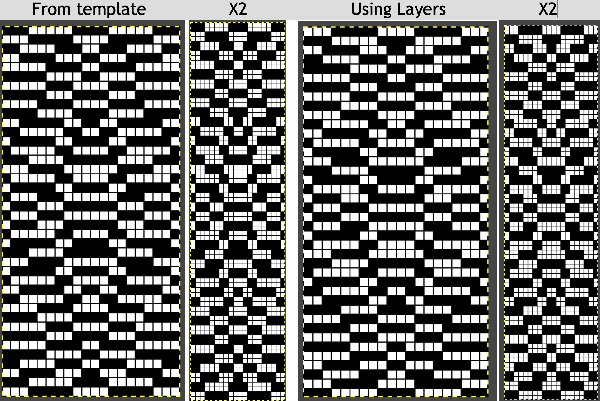 Using bucket fill for the ground in the second layer, as described in the video, the captured clipboard image can be very small
Using bucket fill for the ground in the second layer, as described in the video, the captured clipboard image can be very small 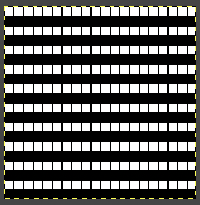 Alternately, the initial design may be scaled X4 to 20 X 80 pixels
Alternately, the initial design may be scaled X4 to 20 X 80 pixels 
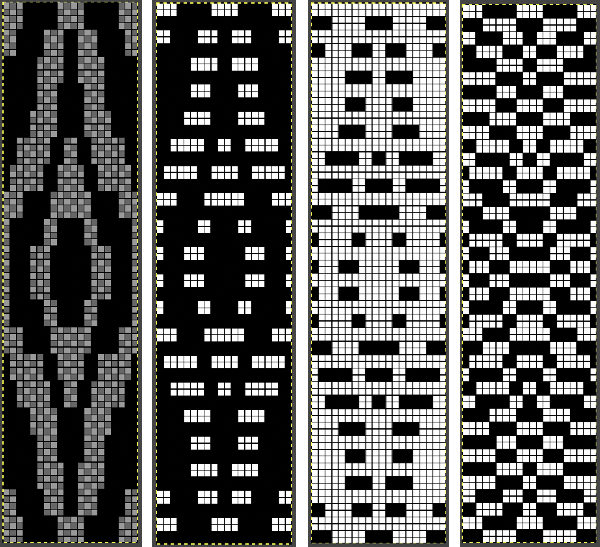

 bring the ribber needles up into work between them
bring the ribber needles up into work between them 
 drop the ribber
drop the ribber 